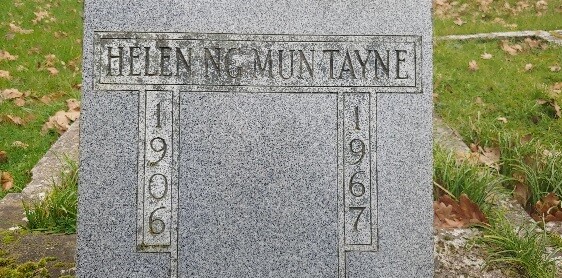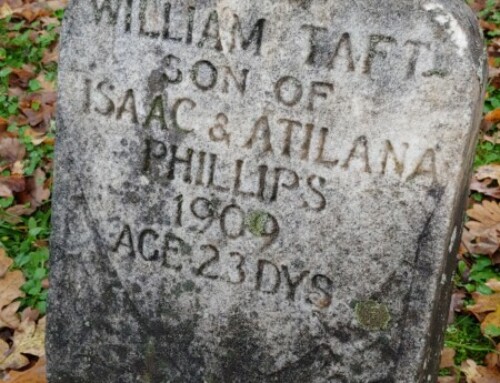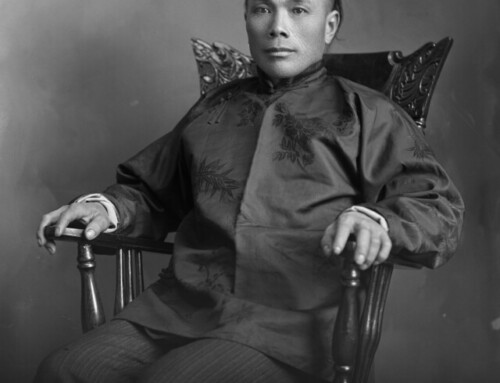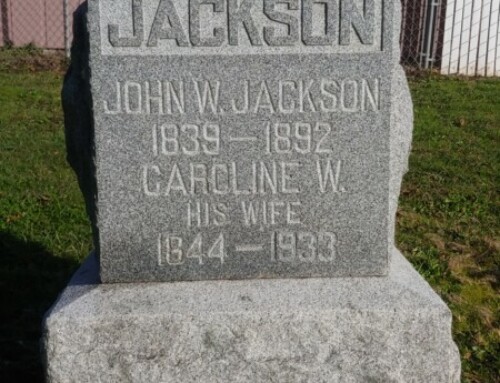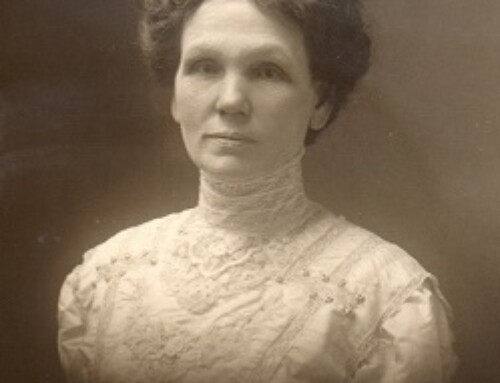A century ago, the first part of April was marked by many of Salem’s Chinese American community with a pilgrimage to the Salem Pioneer Cemetery in celebration of the Qing Ming Festival. Part of the ritual included the sweeping of grave markers and the presentation of offerings on a low set, concrete funerary table or altar.[1] It was an opportunity to remember those who had passed and to celebrate with the living.
An archaeological project undertaken by the City of Salem and many partners helped uncover the old funerary table at the cemetery. A renewed annual celebration of Qing Ming was established in 2018. Learn more about the renewed festival here: https://www.cityofsalem.net/Pages/chinese-qingming-festival.aspx.
In honor the festival, I’d like to do some figurative sweeping of the dust off the story and memory of Helen Ng Mun Tayne. Her grave marker is one of four matching stones that stand in a neat row not too far from the funerary table. The unassuming marker, set next to her brother, mother and stepfather, belies a remarkable life of service to her country and brushes with famous names from the history books.
A Note about Naming
A quick note about names. I am using the name Helen Ng Mun Tayne, the name that appears on her headstone, because that is how she signed her name in later correspondence and how she is identified in her military documentation. But in the various documents marking her life milestones, many names were used. A snippet from testimony she gave before an immigration inspector in Portland on August 1, 1928, provides an overview and explanation of some of those names. (More about why she had to give testimony to an immigration inspector later). When asked by the inspector to state her name she replied: “My name—the name that my certificate was filled out – is Helen Chung.” When asked if she had any other names, she replied: “My Chinese name is Ng Mun Tayne; also known as Ng Fong Ching, which is the same name in a different dialect.”[2] Chinese naming practices differ from those used by English speakers. In Chinese, the surname or family name is listed first, followed by given names. In Helen’s case “Ng” was her family name. Chung was one of her father’s given names.
Helen Ng Mun Tayne
Helen Ng Mun Tayne was born on a hop ranch[3] not too far away from Salem’s Pioneer Cemetery on 28 April 1906.[4] Her father, Ng Lung Chung, rented the property from E.M. Croisan.[5] As a first-generation immigrant from China, Helen’s father was not allowed to apply for naturalization or to purchase property in the United States. Ng Lung Chung, who also went by the name of Gong, was a skillful farmer. His 1910 harvest on the Croisan property produced what one newspaper declared “a phenomenal yield of over a ton of hops to the acre” – made even more remarkable because 1910 had been considered an off year for hop production.[6] Hop farming was a part of family life, the 1910 Census shows Helen’s immediate family shared a house with 6 other single men (Chinese, Korean and white) all listed as boarders and laborers in the hop fields.[7]
Helen’s mother, Dora, was born in Port Townsend, Washington. Helen had two brothers and two sisters: Harry Ng Mun Gate (also known as Charlie Chung or Ng Tin Yee), Alice Esther Chung (Ng Fong Loon) and Ernest Chung (Ng Soon Mun, also Ernest Howe and Ernest Sing).[8] Another sister, Lucille, died as an infant and is also buried in the Pioneer Cemetery, several lots to the east.[9]
Helen attended Salem schools through 9th grade,[10] but many of the names may be unfamiliar to today’s reader. She started at Lincoln School — the elementary school that was once where St. Paul’s Episcopal Church now stands (1444 Liberty St SE).[11] Richmond School remains, but Washington Junior High was the name given to Salem’s East School located at 12th and Center Streets (now a Safeway) after 1915[12] when it became a junior high school.[13]
Trip to China
In 9th grade, Helen made her first trip to China with her father. Even though she was an American citizen born in the United States, a strict series of anti-Chinese exclusion laws required that she register and undergo interrogation by the Immigration Service. Sworn statements were also demanded of her mother, sister and father – so that she could submit a Form 430 – “Application of Alleged American-born Chinese for Pre-Investigation of Status.” All of this was above and beyond her additional application for a U.S. passport. This is not the first time Helen and her family had to jump through hoops to prove their Americanness. When she was just two years old, Helen’s father had affidavits drawn up for his children by a lawyer to establish their residency. “We make this affidavit for the purpose of identification and to establish the right of said…Helen B. Chung to remain in this country” –the country of her birth, and her mother’s birth. The affidavit was witnessed by a notary public, Charles Linza McNary, who would go on to serve as the U.S. Senate minority leader and make an (unsuccessful) Vice Presidential bid.[14]
Life of Service
A desire to be of service seems to be a strong theme in Helen’s life. In a 1924 letter to a contact at the Immigration Service in Portland inquiring about work in the consular service she wrote: “For a long time, I have been attracted to such work and now I feel quite capable to undertake such a position if the opportunity offers… I could be of service in the interpreting of the Chinese dialect which I speak, or, act in the capacity of a stenographer when the occasion arises.”[15] The response from her contact was that he did not think that they would hire a Chinese woman.[16] Helen’s secretarial and language skills would eventually be recognized, but it would take a World War to get there.
Discouraged from her dream job, Helen worked around Kelso, Portland and Salem as a stenographer. She eventually worked her way to become the first woman employee of the Oregon-Washington-Montana District 1 of the Public Roads Administration, the precursor to today’s Federal Highway Administration.[17]
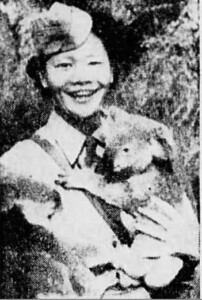
Then Private First Class Helen Ng Mun Tayne on duty in the Pacific Theater during World War II. Originally published in the Capital journal 03 April 1945.
When World War II broke out, new opportunities arose. After serving in the Civil Air Patrol in Salem for a year, she enlisted in the Women’s Army Corps and became a WAC.[18] When asked why she joined, she was quoted by the local paper as saying: “To help the boys who are fighting for us.”[19] After training at Fort Des Moines, she was sent to Camp Davis, North Carolina, and eventually to the Pacific Theatre. Her tour of duty took her through Australia, New Guinea, the Philippines.[20]
While not quite consular service, Helen was attached to General George C. Marshall’s staff in 1946, serving as a secretary[21] during the general’s mission to China to try and avert civil war within the between Nationalists led by Chiang Kai-shek and Communists under Mao Zedong.[22] Upon her departure, General Marshall wrote a personal thank you note to Helen, now preserved as part of the George C. Marshall Foundation collections in Lexington, Virginia. To the then Sergeant Ng he wrote: “In leaving China I wish to thank you for the services you have rendered me for the past several months. Occasions frequently necessitated your working long hours when the situation was most critical. I appreciate your valuable services. With my best wishes to you in the New Year. Faithfully yours.”[23]
In the Army, Helen had found a fulfilling career. She continued to serve, being stationed at Fort McPherson in Georgia[24] (where she started a college degree[25]), Fort Lawton, Washington[26] (where she graduated with a bachelor’s degree from Seattle University[27]), and 14 weeks of training at the Army Intelligence School at Fort Holabird, Maryland.[28] She officially retired from the U.S. Army in 1964 as a Chief Warrant Officer 3, after more than 20 years of service.[29] Just to give a little perspective on how unique achieving that rank was, according to the Warrant Officer Historical Foundation, by 1968 there were only 23 female Warrant Officers in the whole of the U.S. Army.[30]
Helen would not get to enjoy a long retirement. She died of cancer at Portland’s Good Samaritan Hospital on 20 November 1967,[31] after a life of perseverance, boundary breaking and service.
Researched and written by Kylie Pine. First appeared in the Salem Statesman Journal Sunday March 27, 2022. Reproduced here with citations for reference purposes.
Citations
[1] https://en.wikipedia.org/wiki/Qingming_Festival
[2] National Archives Case File 5017/459 Helen Ng Mun Tayne (Helen B. Chung). In other documents she is also listed as Helen Beulah Chung and Helen Lucille Chung and she also signed her name in some correspondence as just Helen Chung.
[3] National Archives Case File 5017/459 Helen Ng Mun Tayne (Helen B. Chung). Testimony given before Inspector R.P. Bonham by Dora Howe 16 March 1921 in Portland. “The next is Helen, or Ng Fong Ching (applicant), born on the Croisan Farm three miles form the Salem court house.”
[4] National Archives Case File 5017/459 Helen Ng Mun Tayne (Helen B. Chung), testimony given before E.A. Dueber, Immigrant Inspector 1 Aug 1928. “Q: What is the date and place of your birth? A. April 28, 1906, just a few miles out of Salem, Oregon.;
[5] National Archives Case File 5017/459 Helen Ng Mun Tayne (Helen B. Chung). Testimony given before Inspector R.P. Bonham by Dora Howe 16 March 1921 in Portland. “The next is Helen, or Ng Fong Ching (applicant), born on the Croisan Farm three miles from the Salem court house.”; See also: “Fine Hop Yield.” “Fine Hop Yield.” Morning Register (Eugene) 08 Sept 1910 pg 8.
The yard is owned by the Hon. E. M. Croisan and is being worked under the lease of Gong, the Chinaman, whom Mr. Croisan says deserves all the credit for the remarkable yield in what is considered an off year…”; It may seem unintuitive, but there are several sources that link Ng Lung Chung, John Gong and Gong as one and the same person. See “Mrs. Dora Lee, Former Salem Resident, Dies.” Capital Journal 28 Jan 1959 pg 13 “Mrs. Lee and her first husband Lung (Gong) Chung)…; Sues on Hop Contract.” Oregon Statesman 15 Apr 1916 pg 5 Complaint was made in circuit court yesterday by Ung Lung Chung who does business as John Gong, against Frank W. Durbin, alleging that $2084.56 is due him on a hop contract. He also asks for costs.
[6] “Fine Hop Yield.” Morning Register (Eugene) 08 Sept 1910 pg 8
Chinaman secures over ton to acre in leased yard.
With but eight acres of hops at West Lake farm stripped from the vines, 1500 boxes have already passed through the driers, producing the phenomenal yield of over a ton of hops to the acre. There are 24 acres, and 4500 boxes in the estimate for the yard.
The yard is owned by the Hon. E. M. Croisan and is being worked under the lease of Gong, the Chinaman, whom Mr. Croisan says deserves all the credit for the remarkable yield in what is considered an off year, and which is much more than it has produced in past seasons.
[8] National Archives Case File 5017/459 Helen Ng Mun Tayne. See testimony from Dora Chung and Helen herself. Also 1910 US Federal Census.
[9] Marion County Death Certificate No. 2628 Lucile Chung. Death at age of 3 months and 29 Days, Salem, Oregon. Father listed as Ung Lung Chung, this is another variation of spelling found consistently for Ng Lung Chung. See also Marion County Birth Certificate 2769 for Female Child born Salem, Oregon 20 Jun 1914. See also listing for gravestone location Salem Pioneer Cemetery: https://www.salempioneercemetery.org/records/display_record.php?id=1524
[10] Testimony given by Helen’s Mother Dora Chung on 16 March 1921 before the US Immigration Service reads (Now National Archives and part of Case File 11420-2 National Archives: “Where did Helen go to school first? A. She started at Lincoln when she was six and then she went to Richmond. Now she is going to Washington Junior High. She is in the 9A.”
[11] St. Paul’s Episcopal Church of Salem: A Chronicle of Parish Life, 1853-2003 Oregon, Salem: ST. Paul’s Episcopal Church of Salem, Oregon, 2003, pg 87. “The old Lincoln School block, bounded by Liberty Myers, High and Leffelle Streets,…would become the site of the Third St. Paul’s Church.”
[12] Weinman, Constance. “A History of the Salem Public Schools, 1893-1916” Marion County History School Days I. Oregon: Marion County Historical Society Volume XIII 1979-1982. Pg 5. Caption with East Salem School Image: “It was completed in 1887 at 12th and center, housed up to 10 grades, then became known as Washington School in 1915 after Salem Senior High opened in 1905 and junior highs established. Washington School was razed in 1949. This photo is dated Oct 30, 1886.
[13] National Archives Case File 5017/39. Testimony given by Dora Howe Chung 16 March 1921 before Inspector in Charge R.P. Bonham. “Q: Where did Helen go to school first? A. She started to Lincoln when she was six and then she went to Richmond. Now she is going to Washington Junior High. She is in the 9A.
[14] https://en.wikipedia.org/wiki/Charles_L._McNary
[15] Letter dated 27 July1924 by Helen Chung to Mr. R. P. Bonham, U.S. Immigration Inspector, Portland. National Archives Records
[16] Letter from R. P. Bonham to Miss Helen Chung date 5 July 1924 National Archives.
[17] Helen B. Ng. Mun Tayne. Capital Journal 31 Dec 1943 pg 4. https://en.wikipedia.org/wiki/Federal_Highway_Administration
[18] See enlistment in WAC. National Archives: NARA – AAD – Display Full Records – Electronic Army Serial Number Merged File, ca. 1938 – 1946 (Enlistment Records) (archives.gov)
[19] Helen B. Ng. Mun Tayne. Capital Journal 31 Dec 1943 pg 4
[20] Helen B. Ng. Mun Tayne. Capital Journal 31 Dec 1943 pg 4; Serving Uncle Sam. Capital Journal 31 Jan 1944 pg 4; “Serving Uncle Sam.” Capital Journal 03 April 1945, pg 7; Made a Corporal. Capital Journal 31 May 1945 pg 3; “Helen Ng Mun Tayne Returning to U.S.” Oregon Statesman 20 Nov 1945 pg 8
[21] “On General Marshall’s Staff.” Capital Journal 19 Oct 1946 pg 9
[22] Kurtz-Phelan, Daniel. The China Mission: George Marshall’s Unfinished War, 1945-1947. New York: W.W. Norton & Company, 2018.
[24] “Helen Mun is feted at Party.” Capital Journal 18 Sep 1952 pg 6; “WAC Here Asks Help In Finding Friend.” Atlanta Constitution. 21 Mar 1951, pg 15
[25] Rampway 1953 Yearbook for the Atlanta Division of the University of Georgia. She is pictured and listed as a sophomore (still wearing her uniform!). Rampway 1953 Yearbook;
[26] Capital Journal 10 Aug 1957 pg 5
[27] 1957 Commencement Program Seattle University
Bachelor’s Degree, Seattle University 1957
[28] Capital Journal 10 Aug 1957 pg 5
[29] 1966 US Army Register, Volume II Army of the United States and Other Retired lists. 1 Jan 1966 pg 279
AUS and Other Retired Lists
Name: Ng-Mun-Tayne, Helen B.
Grade: CW3
SVC No. V-0906970
Date Ret Da Mo Yr 01 01 64 R
Ret List: Res
Ret Code: M2 – 20 or more years of service (WO) (Title 10 USC See 1293)
[30] “History of Women Warrant Officers in the U.S. Army.” Warrant Officer Historical Foundation. https://warrantofficerhistory.org/Hist_Women_WO.htm updated 1 June 2015: “The population of women warrant officers during this period ranged from 23 in 1968 to 46 in 1979. The women warrant officers of 1968 were assigned to the following branches: AG 8; MI: 9; MP: 2; QM: 2; and SC: 2: From 1968 to 1975 the quantity of women warrant officers remained stable throughout this period.”
[31] Death Certificate for Helen B. Ng Mun Tayne. Multnomah County. Accessible via ancestry.com.



